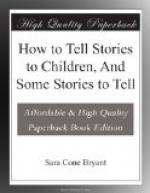The child is an adept at make-believe, but his make-believes are, as a rule, practical and serious. It is credulity rather than imagination which helps him. He takes the tales he has been told, the facts he has observed, and for the most part reproduces them to the best of his ability. And “nothing,” as Stevenson says, “can stagger a child’s faith; he accepts the clumsiest substitutes and can swallow the most staring incongruities. The chair he has just been besieging as a castle is taken away for the accommodation of a morning visitor and he is nothing abashed; he can skirmish by the hour with a stationary coal-scuttle; in the midst of the enchanted pleasuance he can see, without sensible shock, the gardener soberly digging potatoes for the day’s dinner.”
The child, in fact, is neither undeveloped “grown-up” nor unspoiled angel. Perhaps he has a dash of both, but most of all he is akin to the grown person who dreams. With the dreamer and with the child there is that unquestioning acceptance of circumstances as they arise, however unusual and disconcerting they may be. In dreams the wildest, most improbable and fantastic things happen, but they are not so to the dreamer. The veriest cynic amongst us must take his dreams seriously and without a sneer, whether he is forced to leap from the edge of a precipice, whether he finds himself utterly incapable of packing his trunk in time for the train, whether in spite of his distress at the impropriety, he finds himself at a dinner-party minus his collar, or whether the riches of El Dorado are laid at his feet. For him at the time it is all quite real and harassingly or splendidly important.
To the child and to the dreamer all things are possible; frogs may talk, bears may be turned into princes, gallant tailors may overcome giants, fir-trees may be filled with ambitions. A chair may become a horse, a chest of drawers a coach and six, a hearthrug a battlefield, a newspaper a crown of gold. And these are facts which the story-teller must realise, and choose and shape the stories accordingly.
Many an old book, which to a modern grown person may seem prim and over-rigid, will be to the child a delight; for him the primness and the severity slip away, the story remains. Such a book as Mrs Sherwood’s Fairchild Family is an example of this. To a grown person reading it for the first time, the loafing propensities of the immaculate Mrs Fairchild, who never does a hand’s turn of good work for anyone from cover to cover, the hard piety, the snobbishness, the brutality of taking the children to the old gallows and seating them before the dangling remains of a murderer, while the lesson of brotherly love is impressed are shocking when they are not amusing; but to the child the doings of the naughty and repentant little Fairchilds are engrossing; and experience proves to us that the twentieth-century child is as eager for the book as were ever his nineteenth-century grandfather and grandmother.




